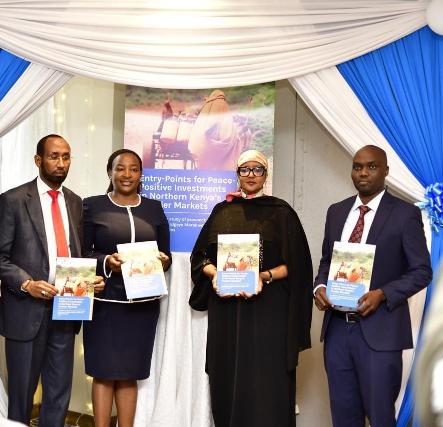
Investors have been urged to take advantage of the immense
investment opportunities that exist in Northern Kenya.
This is after research by Interpeace revealed entry points for peace-positive investment in Northern Kenya’s frontier markets.
The feasibility study on peace-positive investment was
conducted in Elgeyo Marakwet, Mandera and Marsabit counties.
The research findings released in Nairobi on Thursday
revealed major opportunities that can unlock the region’s economic potential
and narrow the development gap between these historically marginalised counties
and other regions of Kenya.
It revealed these counties are endowed with abundant natural
and artificial resource production potential.
These include agriculture, livestock, fisheries, trade,
infrastructure, storage and transport, renewable energy, services, manufacturing,
mining, tourism and vast open land optimal for large-scale irrigation and
agribusiness opportunities.
The counties are also strategically located, bordering
Somalia and Ethiopia, providing vast cross-border market opportunities.
Principal Secretary Teresia Mbaika said a huge array of
untapped resources can be unlocked through sustainable public-private
investment partnerships.
This, she said, can effectively mitigate social and conflict
risks, create a cycle of stability, foster self-reliance, and build long-term
prosperity.
Mbaika is the PS, State Department for Devolution in the
Office of the Deputy President.
Mbaika noted that peace-responsive investments can help address
drivers of conflict in the regions, reduce the underlying causes, and
strengthen social cohesion.
This will ultimately help to reduce risk and make the
investments more sustainable in the long run.
She said the success of Peace Finance required a
multi-faceted strategy that incorporates peace and climate-responsive measures,
incorporating key ethnic groups, political leaders, security agencies,
marginalised community members, formal and informal community networks and
local elites.
International development partners should also support the
integration of peacebuilding into investment to help unlock capital markets
for greater investment in infrastructure financing.
“A nexus exists between peace, development and investment.
Without peace, there cannot be development and without development, there can
be no peace,” Mbaika said.
“Through peace-positive investments, it is possible to
transform Northern Kenya into a progressive peace investment region,” she said.
Mbaika was speaking during a multi-stakeholder meeting held
under the theme, ‘Exploring Peace-Positive Investment Opportunities in Northern
Kenya organised by Interpeace.
The conference aimed to catalyse discussion and a collective
approach to how investment in Kenya should be shaped in order to be
peace-aligned, taking Northern Kenya as an example.
The event was attended by representatives from financial
institutions, multi-laterals, embassies, government representatives,
international foundations, and civil society organisations.
Ambassador Amina Mohammed who is a member of the Interpeace
Governing Board, highlighted the importance of inclusive investment strategies.
Mohammed noted that by integrating peace efforts into
investment frameworks, the counties can mitigate risks, enhance returns, and
contribute significantly to a peaceful and prosperous Northern Kenya.
She said the impact of conflict in northern Kenya was deeply
intertwined with the region’s underdevelopment noting that prolonged conflicts
have significantly affected the livelihoods, well-being and economic progress of the
region.
Livestock production and agriculture in Mandera and Marsabit
present notable peace-positive investment potential, while in Marsabit, there
is significant opportunity to invest in large infrastructure projects in a more
peace-positive approach as there are existing and planned investments in water
management and energy.
The fisheries sector, particularly around Lake Turkana,
offers significant peace-positive investment potential, with investments needed
in cold chain facilities, fish landing sites, and market outlets to reduce
post-harvest losses and improve socio-economic conditions.











